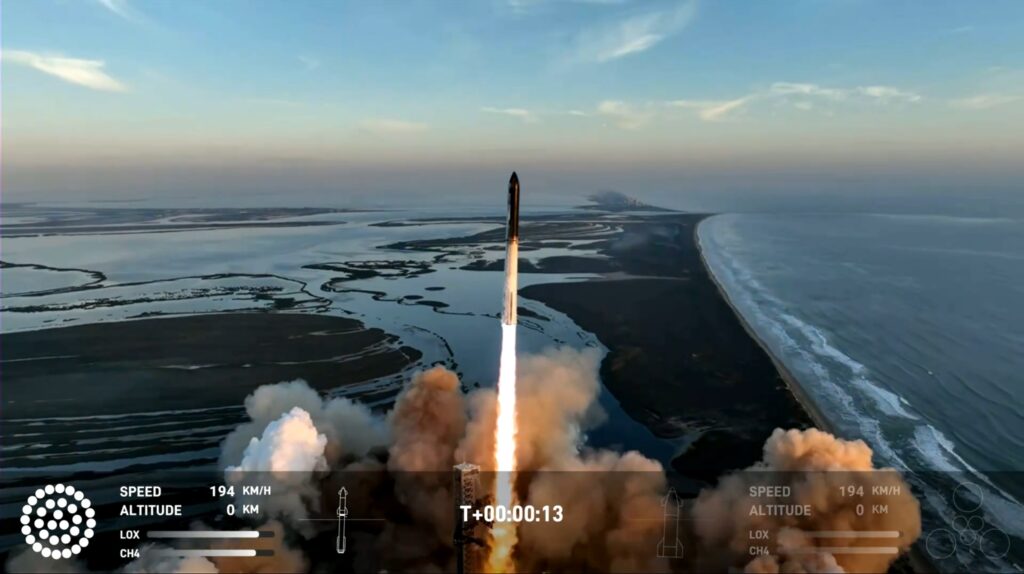Updated 2:30 p.m. Eastern with additional comments.
BERLIN — SpaceX’s Starship vehicle reached space on its second integrated test flight Nov. 18 but broke apart late in its ascent after successfully demonstrating the performance of its booster and a new stage separation technique.
The Starship/Super Heavy vehicle lifted off from SpaceX’s Starbase test site at Boca Chica, Texas, at about 8:03 a.m. Eastern. Liftoff was delayed a few minutes because of a “late pressurization” issue with the upper stage, but no other issues were reported during the countdown.

The Super Heavy booster appeared to perform normally during its ascent, without any obvious failures of its Raptor engines, unlike the first flight in April where several Raptors shut down. Starship then ignited its six engines and separated from the booster about 2 minutes and 45 seconds after liftoff, testing a new “hot staging” technique where engine ignition takes place before stage separation to improve performance.
Super Heavy then planned to perform a “boostback” maneuver to prepare for a splashdown in the Gulf of Mexico. However, at about 3 minutes and 30 seconds after liftoff the booster broke apart in what SpaceX called a “rapid unscheduled disassembly.” The cause for the breakup was not immediately clear, although SpaceX hosts of its launch webcast noted that one purpose for the flight was to test how the booster could manage the stresses from the hot staging.
The Starship continued to ascend, with a planned engine cutoff eight and a half minutes after liftoff. However, near the end of the burn contact with the vehicle was lost. At the time of the loss of telemetry, Starship was at an altitude of 148 kilometers and going more than 24,000 kilometers per hour, close to orbital velocity.
“We think we may have lost the second stage,” John Insprucker, principal integration engineer at SpaceX, said on the webcast. He said the automated flight termination system on Starship was activated “very late in the burn” but did not indicate why.
The Federal Aviation Administration, in a statement after the launch, confirmed that there was a mishap without any injuries or damage, which would be expected given the location of both the booster and ship breakups. It added that it would oversee a SpaceX-led mishap investigation, which is standard in the event of a launch failure.
The plan for the flight was to perform nearly one trip around the planet, not go into orbit. Starship would have reentered and splashed down near Hawaii 90 minutes after liftoff.
This flight, though, made significant progress compared to the first test flight in April That launch ended four minutes after liftoff when the vehicle’s flight termination system destroyed the rocket, which had started to tumble. The Super Heavy booster suffered several engine failures during ascent that doomed the vehicle. SpaceX Chief Executive Elon Musk said that the booster used a “hodgepodge” of older engines.
Musk said in June that the company made “well over a thousand” changes to the vehicle from the first flight. Besides fixes to correct the problems that caused the failure of the first flight, the biggest change for this mission was to switch to the hot staging approach.
SpaceX also improved ground infrastructure, which was damaged by the exhaust of the Super Heavy’s Raptor engines, sending debris as far as 10 kilometers from the pad. The company installed a water deluge system intended to protect the concrete pad from damage. That system, though, required an environmental review by the U.S. Fish and Wildlife Service that delayed completion of an updated Federal Aviation Administration launch license until Nov. 15.
Starship is essential to both SpaceX’s and NASA’s future. SpaceX is counting on Starship to be able to launch payloads such as full-sized V2 Starlink satellites. The company is currently launching smaller versions of those satellites on Falcon 9 rockets, but the more capable V2 Starlink satellites are designed for Starship.
SpaceX also has awards valued at $4 billion from NASA to develop a lunar lander version of Starship for the Artemis lunar exploration campaign, including crewed landings on the moon for the Artemis 3 and 4 missions.
NASA officials said at a Nov. 17 meeting of an advisory committee that they will be closely watching the launch. They noted, though, that a single lunar lander mission will take “in the high teens” of launches of Starship/Super Heavy for the lander itself as well as to deliver propellants to a depot in Earth orbit that will fuel the lander for its trip to the moon.
“Congrats to the teams who made progress on today’s flight test,” NASA Administrator Bill Nelson said in a social media post after the launch. “Today’s test is an opportunity to learn—then fly again.”
“Each test represents a step closer to putting the first woman on the Moon with the Artemis III Starship human landing system,” said Jim Free, NASA associate administrator for exploration systems development, in another post. “Looking forward to seeing what can be learned from this test that moves us closer to the next milestone.”

- SEO Powered Content & PR Distribution. Get Amplified Today.
- PlatoData.Network Vertical Generative Ai. Empower Yourself. Access Here.
- PlatoAiStream. Web3 Intelligence. Knowledge Amplified. Access Here.
- PlatoESG. Carbon, CleanTech, Energy, Environment, Solar, Waste Management. Access Here.
- PlatoHealth. Biotech and Clinical Trials Intelligence. Access Here.
- Source: https://spacenews.com/starship-super-heavy-lifts-off-on-second-flight/



